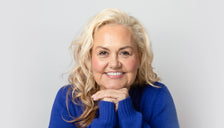Shop the full Skin Rocks Range
I used to get my SPF from my make-up during colder months, but since I’ve gotten older and have been using more retinoids, I’ve stepped up my SPF usage through winter – and in the summer I use SPF 50 daily. A dedicated sunscreen that gives both UVA and UVB protection. UVC doesn’t penetrate that atmosphere so we don’t need to worry on that score. I prefer dedicated spf products, as opposed to moisturisers with added spf. My problem with SPF in moisturisers is two-fold:- It gives you a false sense of security. In the 1920’s the incidences of melanoma – with no SPF available – were around 1 in 1500. In 2013 they are 1 in 53 – with years of SPF being available and modern science – 1 in 53. Why? Because we apply it once and move on, thinking we’re done. If you use a moisturiser containing SPF 15 (for example) at 8am in the morning – assuming you apply it all over your face (most people leave out areas of their face when moisturising) – if you would normally burn in 15 minutes of sun exposure, technically you should be reapplying your SPF at 11.45am. How are you going to do that without removing your full face of makeup? I know no-one that takes their makeup off halfway through the day to reapply sunscreen. If you apply your SPF moisturiser religiously every day and think you are protected – you may not be.
- A moisturiser containing SPF frequently only protects from UVB – it does not protect you from UVA. So, you won’t burn, but your collagen will break down and you’ll still get wrinkles. Excellent. Also – SPF moisturisers are less likely to be rub-resistant or water-resistant. If you then apply your makeup with fingers or a brush (everyone) or perspire/sweat – it’s gone. Make sure you check for 'broad spectrum'.
If you want proper protection from the sun you need to use a broad-spectrum sun protectant cream – a dedicated product that’s sole purpose is to protect your skin from the damage the sun does to it. Honestly? Companies that add SPF to their general ‘anti-ageing’ moisturisers are throwing it in there as an ‘added benefit’ and a sales tool.
Sun protection is not an ‘added benefit’. It’s a critical, proven step to protect from ageing. The round UVA symbol can only be shown on packaging of a product that has proven to provide at least a third of its protection against UVA. Not just UVB. In terms of routine?
- cleanse
- tone
- serum (if you use)
- moisturiser (non-spf!)
- SPF product
- makeup
- Low = 6-14
- Medium = 15-29
- High = 30-50
- Very high = 50+
If you are fair, Caucasian, ‘pale’ – you should be in the ‘High’ category. If you are any type of ethnicity that tans easily and rarely burns you can use medium as long as you use it wisely. If you are a redhead however you are strictly in the ‘Very high’ category. Redheads with freckles have phaeomelanin – opposed to the rest of us that have eumelanin. You’ll burn easily, quickly and the damage will be long-lasting. If you use an SPF in the low-medium category you will tan. If you don’t want any colour at all you need to use 30 and above and reapply frequently.
N.B. – SPF degrades. Buy new each year.
When I use Woods Lamps or similar technology on clients the main areas that nearly always show damage are the tops of the ears (ALWAYS the top of the ears), the back of the neck and the tip of the nose. Forewarned is forearmed. Enjoy the sun. I LOVE the sun. Just protect yourself.































